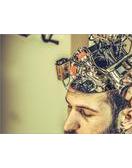Long before Gary was diagnosed, we visited the zoo with our family, excited to explore the exhibits. The reptile house was always a favorite stop, but as we ventured deeper into the dimly lit hallway, I noticed Gary's steps becoming more hesitant. When we reached the main room, with only accent lights highlighting the reptiles, Gary suddenly lost his balance. He reached out, gripping the wall to prevent a fall. We were both puzzled and concerned. Why did the darkness affect him so profoundly? Our evening walks, too, became a challenge. Whenever we strolled through areas where trees cast dark, shadowy patches on the road, Gary would experience unsettling feelings of vertigo. Only later, we connected these incidents to a more significant issue: neurodegenerative disorders and balance, specifically Superficial Siderosis (SS).
The Link Between Neurodegenerative Disorders and Balance
Superficial Siderosis: A Silent Thief of Balance
Superficial Siderosis is a rare neurodegenerative disorder caused by iron accumulation in the brain and spinal cord. This iron deposition damages the nerve cells responsible for various functions, including balance. Patients like Gary often experience balance issues as the disease progresses, especially in low-light conditions.
The Role of Vision in Maintaining Equilibrium
Our vision plays a crucial role in maintaining balance. It provides essential information to our brain about our surroundings. Iron accumulation can affect the visual pathways of SS patients, making it challenging to process visual cues, especially in dimly lit environments. This disruption can lead to feelings of disorientation and increased fall risk.
Shadows, Dusk, and the Dark: Why They Pose a Risk
The Challenge of Processing Incomplete Visual Data
Walking through shadows or in the dark means our eyes receive incomplete or distorted visual data. For most, the brain compensates by relying more on other senses. However, for those with SS, the damaged neural pathways struggle to process this fragmented information, leading to balance issues.
The Interplay of Visual and Vestibular Systems
Our vestibular system in the inner ear works with our vision to maintain balance. In SS patients, both these systems can be compromised. When walking in the dark or through shadows, the brain receives conflicting signals, leading to feelings of vertigo, as Gary experienced.
Superficial Siderosis Vision Problems
The Impact of Iron Deposition on Vision
Iron accumulation in SS not only affects balance but also vision directly. Patients may experience blurred vision, difficulty adjusting to different light levels, or double vision. These visual challenges further exacerbate balance issues, especially in challenging lighting conditions.
The Emotional Toll of Vision and Balance Issues
Beyond the physical challenges, SS patients often grapple with feelings of frustration, anxiety, and fear, especially when navigating unfamiliar or dimly lit environments. Understanding and addressing these emotional aspects is crucial for their well-being.
Assistive Devices to Prevent Falls
Walking Sticks and Hiking Poles: Essential Tools for Maintaining Balance
The Science Behind Walking Sticks and Hiking Poles
Walking sticks and hiking poles are designed to provide additional points of contact with the ground, thereby increasing stability and balance. By distributing the body's weight more evenly and offering support, they reduce the strain on the lower body and provide a sense of security.
Benefits for Individuals with Neurodegenerative Disorders
- Enhanced Stability: For those with SS who may experience a sudden loss of balance, walking sticks or hiking poles act as an extension of the arms, providing immediate support and preventing falls.
- Improved Confidence: Knowing readily available support can boost confidence, encouraging individuals to engage in activities they might otherwise avoid due to fear of falling.
- Adaptation to Various Terrains: These aids are versatile and can be used on different surfaces, whether it's smooth pavement or a rugged hiking trail. This adaptability makes them suitable for various outdoor activities, even in low-light conditions where the balance might be more challenging.
- Customizable Support: Many walking sticks and hiking poles come with adjustable lengths and ergonomic grips, allowing for a personalized fit. This customization ensures that support aligns with the individual's needs and preferences.
- Encouragement of Proper Posture: By promoting an upright posture, these tools can alleviate back pain and reduce fatigue, further enhancing the walking experience.
Choosing the Right Walking Stick or Hiking Pole
Selecting the right walking stick or hiking pole depends on individual needs, preferences, and the intended use. Factors to consider include:
- Material: Lightweight materials like aluminum or carbon fiber offer ease of use without sacrificing strength.
- Grip: Ergonomic grips provide comfort and control, reducing the risk of slipping.
- Adjustability: Adjustable lengths cater to different heights and walking styles.
- Additional Features: Some models come with shock absorbers, wrist straps, or interchangeable tips for various terrains.
Walking sticks and hiking poles are more than mere accessories; they are vital tools that can significantly enhance the quality of life for those dealing with neurodegenerative disorders and balance issues. Individuals can explore the world more freely and confidently by offering physical support and psychological reassurance.
Wearable Technology for Balance
How Wearable Tech Assists with Balance
Wearable devices designed to assist with balance typically incorporate a combination of sensors, such as accelerometers, gyroscopes, and magnetometers. These sensors detect movements and orientation in real-time. When the device senses a potential imbalance or an activity that deviates from the norm, it can send alerts or feedback to the user. This feedback can be in vibrations, sounds, or visual cues, allowing the individual to adjust their posture or movement accordingly.

